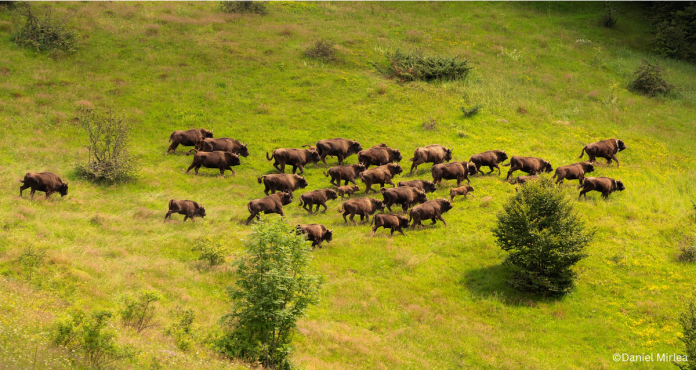The animals which were resettled in the Țarcu mountains in southwest Romania are stimulating plant growth and securing carbon stored in the soil while grazing
A herd of 170 bison reintroduced to Romania ten years ago are being hailed as heroes against climate change as new research shows they could help store CO2 emissions equivalent to removing almost 2 million cars from the road for a year.
European bison disappeared from Romania more than 200 years ago, but Rewilding Europe and WWF Romania reintroduced the species to the southern Carpathian mountains in 2014.
Since then, more than 100 bison have been given new homes in the Țarcu mountains, growing to more than 170 animals today which is one of the largest free-roaming populations in Europe.
The latest research, which has not been peer-reviewed, used a new model developed by scientists at the Yale School of the Environment and funded by the Global Rewilding Alliance, with the bison paper funded by WWF Netherlands, a press release said.
The model calculates the additional amount of atmospheric CO2 that wildlife species help to capture and store in soils through their interactions within ecosystems. The European bison herd grazing in an area of nearly 50 sq km of grasslands within the wider Țarcu mountains, was found to potentially capture an additional 2 million tons of carbon a year, about 9.8 times more than without the bison. This corresponds to the yearly CO2 emissions of 1.88m average US petrol cars.
The mosaic landscape of the Carpathians offers a variety of habitats, such as forests, meadows and areas of natural regeneration, thus more food resources for bison.
Prof Oswald Schmitz of the Yale School of the Environment in Connecticut in the US, who was the lead author of the report, said: “Bison influence grassland and forest ecosystems by grazing grasslands evenly, recycling nutrients to fertilize the soil and all of its life, dispersing seeds to enrich the ecosystem, and compacting the soil to prevent stored carbon from being released.
“These creatures evolved for millions of years with grassland and forest ecosystems, and their removal, especially where grasslands have been plowed up, has led to the release of vast amounts of carbon.
„Restoring these ecosystems can bring back balance, and ‘rewilded’ bison are some of the climate heroes that can help achieve this.”
















